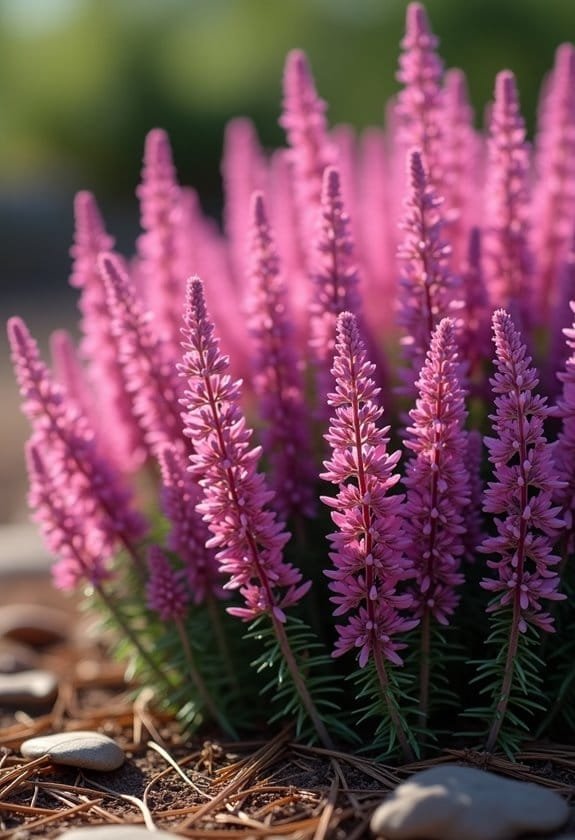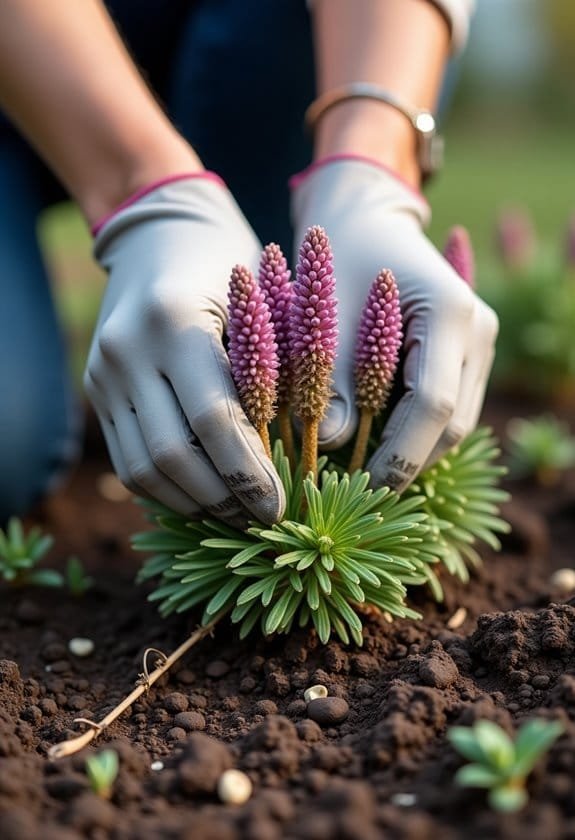Calluna vulgaris, commonly known as heather or ling, represents a hardy perennial shrub that thrives in acidic soils across European heathlands. It's characterized by tiny needle-like leaves and produces stunning purple-mauve blooms from July to September, growing to heights of 30-50 cm. This resilient plant serves as a crucial ecological cornerstone, providing essential sustenance for pollinators and wildlife, particularly red grouse, while contributing to soil stabilization. Heather's cultural significance extends beyond its natural habitat, as it's prized in ornamental gardening and symbolizes resilience in Scottish folklore. The plant's remarkable adaptability and diverse benefits make it an intriguing subject for both naturalists and gardeners.
Main Points
- Calluna vulgaris is a hardy flowering shrub with small needle-like leaves and purple-mauve blooms, commonly found in European heathlands.
- The plant grows 30-50 cm tall, requires full sun, and thrives in acidic, well-drained soils with pH below 6.0.
- Heather flowers from July to September, providing essential nectar for bees and butterflies while supporting various wildlife, especially red grouse.
- Regular pruning in spring promotes flowering, and young plants need consistent moisture for successful establishment in their first 18 months.
- The plant holds cultural significance in Scottish folklore, symbolizing resilience and beauty, while producing prized heather honey.
Introduction

Calluna vulgaris, commonly known as heather or ling, stands as one of Europe's most iconic flowering shrubs, gracing landscapes with its distinctive purple-mauve blooms.
This hardy perennial plant, belonging to the Ericaceae family, demonstrates remarkable adaptability to challenging environments, thriving in acidic soils across heathlands and moorlands throughout the continent.
The species has woven itself into both ecological and cultural narratives, serving as an essential resource for wildlife while historically symbolizing resilience in European folklore and traditional practices.
Common Name
The plant commonly known as "heather" or "ling" represents the species Calluna vulgaris, with "ling" being particularly prevalent in British usage for wild varieties. This versatile plant has earned its widespread recognition through its extensive presence across moorlands and heath environments, where it has flourished for centuries and shaped the landscape's character.
The designation "Scotch heather" emphasizes the plant's strong cultural connection to Scotland, where it has become deeply woven into the region's folklore and traditional practices. In Scottish culture, common heather symbolizes both admiration and beauty, reflecting the plant's aesthetic appeal and its importance in local customs.
The name "heather" itself derives from its natural habitat preferences, directly linking the plant to the heath environments where it thrives so remarkably well.
Calluna vulgaris's naming conventions often reflect its visual characteristics, particularly its stunning floral displays in mauve and pink hues, which have contributed greatly to its popularity in ornamental gardening. These distinctive blooms have helped cement its position as both a beloved wild species and a cultivated garden favorite.
Scientific Name
Scientifically known as Calluna vulgaris, this iconic heather species draws its name from two distinct linguistic roots: the Ancient Greek "Kallyno," meaning to beautify or cleanse, and the Latin "vulgaris," which denotes its widespread occurrence in nature.
As a member of the family Ericaceae, Calluna vulgaris stands distinct from its close relatives in the genus Erica through its unique floral architecture. The plant's distinctive characteristics include remarkably small leaves, measuring just 2-3 millimeters, which grow in opposite pairs rather than the whorled arrangement found in Erica species.
These botanical features serve as essential identifiers for taxonomists and botanists studying heather flowers.
The species' scientific classification reflects both its aesthetic appeal and ubiquitous presence across diverse landscapes, from European moorlands to Icelandic terrain.
During its peak flowering period from July through September, Calluna vulgaris produces primarily mauve blooms, though white variants occasionally emerge.
This scientific naming convention not only anchors the plant's identity within botanical literature but also highlights its ecological significance as an important resource for wildlife.
Overview
Widely recognized across European landscapes, heather stands as one of nature's most resilient and versatile flowering plants. This remarkable shrub, thriving in challenging environments from sea level to mountainous terrain, demonstrates exceptional adaptability across diverse ecological conditions. Its presence transforms vast stretches of land into vibrant carpets of purple and pink during the summer months, creating stunning natural displays that have captured human imagination for centuries.
As a cornerstone species of heathland ecosystems, these plants play an essential role in maintaining environmental stability through their extensive root systems, which effectively prevent soil erosion while contributing to carbon sequestration.
Their ability to flourish in acidic, nutrient-poor soil has enabled them to colonize areas where many other plants struggle to survive. The plant's ecological significance extends beyond its physical presence, as it provides key resources for wildlife, particularly serving as a critical food source for red grouse populations.
Moreover, its cultural impact resonates through traditional medicine and modern agricultural practices, where specialized heather honey production continues to hold considerable economic value in various European regions.
Key Features
Calluna vulgaris presents itself as a compact evergreen shrub, typically reaching heights between 30 to 50 centimeters, with distinctive tiny leaves arranged in opposing pairs.
The plant's most striking feature appears during its flowering season from July through September, when clusters of mainly mauve or occasionally white blooms emerge against the dark green foliage.
Its refined structure showcases small leaves measuring just 2-3 millimeters, creating a dense, textural appearance that distinguishes it from similar species in the heather family.
Growth Size
Naturally growing as an evergreen dwarf shrub, Calluna vulgaris reaches heights between 30 to 50 cm (12 to 20 inches) and spreads horizontally to create effective ground coverage.
The growth habit of these acid-loving plants exhibits remarkable versatility, with different cultivars displaying varying sizes to suit diverse landscaping needs.
Among the heather plants, cultivar selection considerably influences mature size, as demonstrated by varieties like 'Firefly,' which showcases a more substantial presence at 45-50 cm tall.
In contrast, compact varieties such as 'Jana' maintain a more modest stature of 20-30 cm, making them ideal for smaller garden spaces or border plantings.
The plant's adaptability to various soil conditions, including rocky or sandy environments, doesn't impact its size potential, though growing conditions may influence its spread rate.
During the extended blooming period from July through November, the plant maintains its characteristic height while producing flowers that enhance its vertical dimension, creating a visually striking display that persists throughout multiple seasons.
Appearance
Distinguished by its delicate features, heather displays small, needle-like leaves that measure just 2-3 mm in length and grow in opposite pairs along its stems. This distinctive leaf arrangement sets it apart from related Erica species, which typically showcase their foliage in whorls rather than pairs.
The plant's most striking appearance feature emerges during its blooming period from July through September, when it produces abundant racemes of bell-shaped flowers. These delicate blooms largely appear in rich mauve and purple hues, though some cultivars present pristine white variations. Notable varieties like 'Dark Beauty' and 'Firefly' exhibit particularly vivid coloration, adding to the plant's ornamental appeal. The flowers can appear in both single and double forms, creating varying levels of visual density along the stems.
Heather's evergreen nature guarantees year-round visual interest, with its compact growth habit forming dense mats of foliage. The plant maintains its attractive appearance even in harsh conditions, demonstrating remarkable resilience while contributing consistent structure and color to landscapes throughout all seasons.
Flowering Season
Throughout the summer months and into early autumn, Calluna vulgaris bursts into a spectacular display of flowers, with its main blooming period spanning from July through September. The flowering period extends seamlessly through the season, with some varieties continuing their vibrant display well into November, providing vital nectar for pollinators during critical months.
While the predominant flower color is a rich mauve or purple, creating a beautiful contrast against the plant's deep green foliage, there are also less common white varieties that add diversity to heather gardens. The flowering stems produce elegant terminal racemes adorned with distinctive bell-shaped blooms, which create a mesmerizing carpet of color across landscapes where heather needs are met.
Specialized cultivars, such as 'Firefly,' introduce unique variations to the traditional flowering pattern, showcasing dark pink blossoms during the August-September window. These flowering characteristics make Calluna vulgaris particularly valuable for maintaining garden interest through late summer, while simultaneously supporting local ecosystems by providing essential resources for bees and butterflies during their active foraging period.
Growing Requirements

Calluna vulgaris demands specific growing conditions to flourish, with full sun exposure being essential for ideal growth and flowering patterns.
The plant shows a marked preference for acidic, well-drained soils with a pH below 6.0, creating an environment that mirrors its natural habitat in rocky or sandy terrain.
While young plants require consistent moisture with weekly watering, mature specimens develop impressive drought tolerance, though they benefit from winter protection through strategic mulching in regions with harsh temperatures.
Light
Proper light exposure plays an imperative role in growing healthy Calluna vulgaris plants. These hardy shrubs thrive in full sun conditions, requiring a minimum of six hours of direct sunlight daily to achieve ideal growth and maintain bright green foliage.
When planted in locations that receive adequate sunlight, Calluna vulgaris rewards gardeners with abundant flowering and robust development.
In regions experiencing intense summer heat, these adaptable plants benefit from strategic placement in areas that provide partial shade during peak afternoon hours. However, it's vital to guarantee they still receive sufficient morning and late afternoon sun to maintain their vigor.
During winter months, exposure to bright sunlight becomes particularly important, as it helps preserve the plant's distinctive foliage coloration and overall health in colder climates.
Without adequate light, Calluna vulgaris may develop undesirable leggy growth patterns and experience diminished flowering capacity.
To maximize the plant's potential, gardeners should select planting locations that offer not only appropriate light conditions but also proper air circulation, as these environmental factors work together to support the plant's natural growing habits.
Soil
Soil conditions play a fundamental role in the successful cultivation of Calluna vulgaris. This hardy plant demonstrates a marked preference for acidic soil with a pH range between 4.5 and 6.0, making it particularly intolerant of lime-rich environments. The composition of the growing medium considerably influences the plant's vitality and long-term survival prospects.
To thrive, Calluna vulgaris requires a specialized soil structure that combines sandy texture with abundant humus content, creating an environment that supports both nutrient retention and effective drainage. Gardeners must prioritize good drainage to prevent root rot, as waterlogged conditions can quickly compromise the plant's health.
When cultivating heather in containers, incorporating materials like expanded clay or perlite into acidic soil helps establish ideal growing conditions by enhancing drainage capabilities.
The plant's natural adaptation to poor, rocky terrains reflects its preference for well-drained, slightly moist conditions. This characteristic makes it an excellent choice for challenging garden locations where other plants might struggle, though careful attention must be paid to maintaining proper soil moisture without risking waterlogged conditions.
Water
Successful cultivation of Calluna vulgaris depends heavily on maintaining appropriate water levels throughout the growing season. Young plants require approximately one inch of water weekly to develop robust root systems, establishing a foundation for healthy growth and abundant blooming.
While established heather plants demonstrate moderate water requirements, they may need supplemental irrigation during periods of elevated temperatures or drought conditions.
For ideal growth, gardeners should utilize lime-free rainwater, which helps maintain the acidic soil conditions that Calluna vulgaris prefers. The plants must be grown in well-drained soil, as excessive moisture around the roots can lead to devastating fungal diseases and root rot.
Proper drainage becomes particularly essential during periods of frequent rainfall or in container cultivation, where water management requires careful attention. During winter months, potted specimens need protection from frost damage, which can disrupt their natural water uptake processes.
Experienced growers often relocate container plants indoors or provide adequate insulation to maintain consistent moisture levels, ensuring the plant's survival through challenging weather conditions.
Temperature
The hardy nature of Calluna vulgaris makes it remarkably adaptable to cold climates, thriving in temperatures as low as -20°C (-4°F). This resilient plant's cold tolerance makes it an excellent choice for gardeners in USDA zones 4 through 8, with potential success in zone 3 when given proper winter protection.
While this hardy plant demonstrates impressive cold resistance, it's less tolerant of high temperatures and humidity, particularly in southern regions where such conditions can impede its growth. The plant performs best in cool, moist environments where it can maintain consistent moisture levels without becoming waterlogged.
In warmer zones, partial shade becomes significant for protecting the plant from intense afternoon sun and heat stress.
During winter months, proper temperature management becomes essential for young plants, which benefit from protective mulching to regulate soil temperature fluctuations.
Though established plants show remarkable resilience to cold weather, newly planted specimens require additional care to survive their first winter. Gardeners in colder regions should implement winter protection strategies, such as covering plants with evergreen boughs or applying a thick layer of mulch.
Pollinator Criteria
Calluna vulgaris serves as an essential nectar source for numerous pollinating insects, particularly bees and butterflies seeking sustenance during the critical summer-to-fall blooming period.
The plant's distinctive bell-shaped flowers create an ideal landing platform for pollinators, while their specialized structure guides insects toward rich stores of nectar and pollen.
These efficient pollination mechanisms, combined with the plant's extended flowering season from July through September, make heather an exceptional contributor to pollinator conservation and ecosystem stability.
Attracted Pollinators
Consistently throughout its blooming period from July to September, heather serves as an essential nectar source for numerous pollinators, especially bumblebees and honeybees. The plant's distinctive bell-shaped flowers produce abundant nectar, creating an irresistible attraction for these critical insect species during their foraging activities.
During the late summer and early autumn changeover, when flowering plants become increasingly scarce, Calluna vulgaris emerges as a lifeline for pollinator populations. The flowers' vibrant pink to light violet hues act as natural beacons, efficiently guiding bees to their nectar-rich destinations through visual signaling that aligns with insect color perception.
The plant's significance extends beyond basic sustenance, as it plays an instrumental role in the production of heather honey, a specialized variety praised for its distinctive characteristics.
This symbiotic relationship between heather and its pollinators demonstrates nature's intricate balance, where the plant's survival strategy of providing abundant nectar guarantees its reproduction while simultaneously supporting diverse pollinator communities through challenging seasonal changes.
Pollination Method
Building on its strong appeal to pollinators, Calluna vulgaris exhibits specialized adaptations that optimize its pollination success. The plant's distinctive tubular, bell-shaped flowers serve as efficient delivery systems for both pollen collection and nectar distribution, perfectly accommodating the long tongues of visiting bumblebees.
The pollination method of heather relies heavily on a sophisticated timing mechanism that aligns with peak bee activity during the critical July to September flowering period. During this time, the plant functions as an essential food source for pollinators, offering abundant nectar when other floral resources become increasingly scarce in the late summer landscape.
The structural design of heather's flowers shows remarkable evolutionary refinement, featuring accessible landing platforms that enable bees to move systematically from bloom to bloom. This efficient cross-pollination system not only guarantees the plant's reproduction but also results in the production of highly sought-after heather honey, characterized by its distinctive flavor profile.
The success of this pollination method is evident in the plant's widespread distribution and its crucial role in supporting bee populations throughout its growing season.
Care & Maintenance

Establishing Calluna vulgaris begins with selecting well-draining, acidic soil and positioning plants where they'll receive adequate sunlight throughout the growing season.
Ongoing maintenance requires careful attention to moisture levels, with regular watering during establishment and spring pruning to promote vigorous flowering and prevent woody growth.
These hardy heathers thrive alongside complementary acid-loving plants like rhododendrons and conifers, creating naturalistic groupings that share similar cultural requirements and provide year-round interest.
Planting Tips
Successfully growing Calluna vulgaris requires careful attention to timing and proper care techniques. To plant heather effectively, gardeners should focus on spring planting, which allows the root system to establish itself before winter's challenging conditions arrive.
The plant thrives best in full sun to partial shade locations, where it can harness adequate light for ideal growth and flowering.
Soil preparation plays an essential role in the plant's long-term success, requiring fertile soil that's both well-draining and acidic. A carefully crafted mixture of sandy, humus-rich components creates the perfect growing medium, promoting healthy root development and nutrient uptake.
During the significant establishment period of 18 months, consistent moisture management becomes vital for young plants, though they'll develop impressive drought tolerance once mature.
To maintain the plant's compact form and encourage prolific blooming, implement early spring pruning by reducing the previous year's growth by approximately half. This strategic trimming stimulates dense, bushy growth patterns and guarantees the heather maintains its attractive appearance throughout the growing season.
Ongoing Care
Maintaining healthy Calluna vulgaris requires consistent attention to basic care requirements throughout the growing season. Young plants demand weekly watering of approximately one inch, while established plants demonstrate remarkable drought tolerance, requiring supplemental moisture only during extended dry periods.
For ideal growth, these hardy plants benefit from specific seasonal care routines. In early spring, gardeners should apply an acidifying nitrogen fertilizer if needed, though plants typically thrive without additional nutrients when growing in organic-rich soil.
Annual pruning, performed during overcast spring days, involves cutting back the previous year's growth by half to encourage robust flowering and maintain an attractive shape.
Winter preparation is essential for young specimens, which need protective mulching before the first frost. Established plants, however, showcase impressive cold hardiness once their root systems are well-developed.
Throughout the year, monitoring soil drainage remains vital, as these plants are particularly vulnerable to root rot in waterlogged conditions. Successful ongoing care relies on maintaining the delicate balance between adequate moisture and proper drainage in acidic soil conditions.
Suggested Companions
Choosing the right companions for Calluna vulgaris enhances both its beauty and growing conditions within the garden landscape. Among the best suited companion plants are acid-loving plants like Azaleas and Rhododendrons, which share similar soil preferences and maintenance requirements, creating a harmonious growing environment.
To add architectural interest and textural diversity, ornamental grasses such as Festuca and Carex provide an excellent counterpoint to heather's compact form. The addition of Gaultheria procumbens as a groundcover introduces vibrant berries and glossy foliage, creating striking visual contrasts throughout the seasons.
When planning these combinations, proper spacing of at least 20 centimeters between plants is essential to maintain adequate air circulation and prevent resource competition.
While these companion plantings create stunning visual displays, gardeners should remain vigilant about potential pest issues. Regular monitoring helps identify and address any insect problems that might affect the plant community, ensuring the continued health and significance of both the heather and its carefully selected companions.
This thoughtful approach to companion planting results in a cohesive and thriving garden display.
Common Issues
Calluna vulgaris faces several significant challenges, including powdery mildew that manifests as a dusty coating on leaves and root rot caused by waterlogged conditions.
Pest infestations, particularly mites and scale insects, can compromise plant health by causing leaf distortion and premature leaf drop.
While these issues may seem intimidating, most can be effectively managed through proper cultural practices, such as ensuring excellent drainage, maintaining appropriate humidity levels, and applying targeted treatments like insecticidal soaps when necessary.
Pests/Diseases
Despite its hardy nature, Calluna vulgaris faces several challenging health issues that gardeners need to watch out for. Among the most prevalent concerns is powdery mildew, which manifests as a distinctive white, dusty coating on the plant's foliage, particularly when conditions become humid or when overhead watering practices are employed.
Root rot presents another significant threat to the plant's health, emerging when soil becomes waterlogged and creates an ideal environment for the destructive Phytophthora fungus to thrive. This condition can rapidly compromise the plant's root system, making proper drainage essential for prevention.
Various pests, including persistent mites and scale insects, can wreak havoc on the plant's foliage, causing distortion and leaf drop if left unchecked.
Environmental stress often manifests through browning foliage, while improper fertilization practices can lead to unstable, leggy growth patterns.
Gardeners can manage these issues through targeted approaches, such as using insecticidal soaps for pest control, maintaining well-draining soil conditions, and carefully monitoring fertilizer applications to preserve the plant's natural compact form.
Solutions
Successfully maintaining healthy Calluna vulgaris plants requires a systematic approach to addressing common issues. Heather is one of those plants that demands specific preventive measures, particularly when it comes to protecting against fungal diseases and environmental stressors.
To combat powdery mildew, gardeners should implement proper watering techniques by directing water at the soil level rather than spraying foliage. Creating adequate spacing between plants promotes essential air circulation, while establishing raised beds or amending soil with organic matter helps prevent root rot through improved drainage.
When plants show signs of stress over winter, reducing exposure to harsh winds and providing a light mulch layer can offer protection without smothering the roots.
For leggy growth prevention, strategic pruning after flowering helps maintain compact form, while careful fertilization prevents excessive foliage development at the expense of blooms.
When dealing with pest infestations, regular monitoring allows for early intervention with gentle remedies like water sprays or insecticidal soaps, which effectively control problematic insects while preserving the plant's delicate structure and natural defense mechanisms.
Summary

Known widely as heather or ling, the perennial shrub Calluna vulgaris stands 30-50 cm tall and features delicate bell-shaped flowers in mauve, purple, and white hues. This hardy plant has adapted remarkably well to challenging environments, thriving in acidic, nutrient-poor soils across European heathlands and moorlands.
During its extended blooming period from July through November, Calluna vulgaris transforms landscapes into vibrant carpets of color, while various cultivars offer gardeners a diverse palette of options.
The plant's ecological significance extends far beyond its aesthetic appeal, as it provides essential sustenance for red grouse and creates important habitats for numerous insects and birds.
While Calluna's resilience has made it an invaluable component of its native ecosystems, contributing to soil stabilization and carbon sequestration, this same hardiness has led to concerns in regions like New Zealand.
There, its invasive tendencies have necessitated biological control measures, including the strategic introduction of heather beetles to maintain ecological balance and protect indigenous flora.


